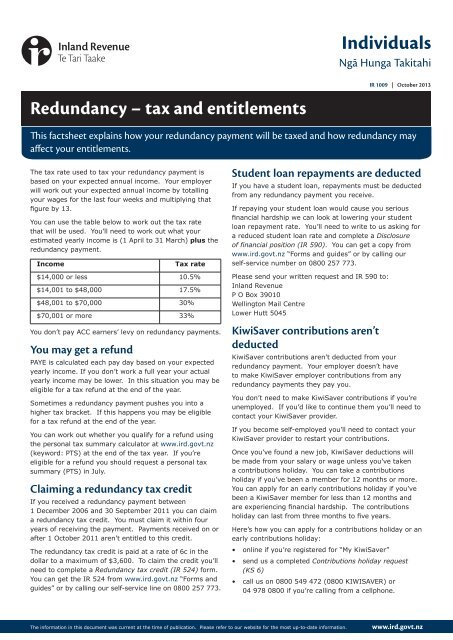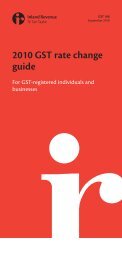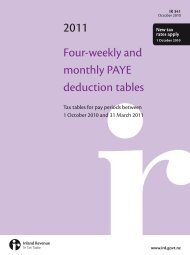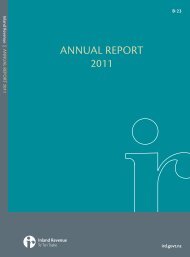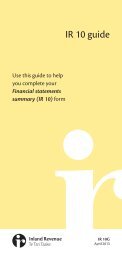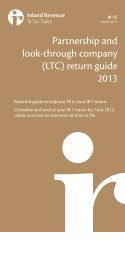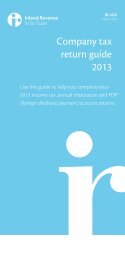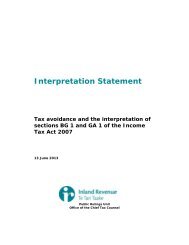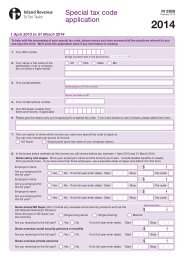Download - Inland Revenue Department
Download - Inland Revenue Department
Download - Inland Revenue Department
You also want an ePaper? Increase the reach of your titles
YUMPU automatically turns print PDFs into web optimized ePapers that Google loves.
Individuals<br />
Ngā Hunga Takitahi<br />
IR 1009 | October 2013<br />
Redundancy – tax and entitlements<br />
This factsheet explains how your redundancy payment will be taxed and how redundancy may<br />
affect your entitlements.<br />
The tax rate used to tax your redundancy payment is<br />
based on your expected annual income. Your employer<br />
will work out your expected annual income by totalling<br />
your wages for the last four weeks and multiplying that<br />
figure by 13.<br />
You can use the table below to work out the tax rate<br />
that will be used. You’ll need to work out what your<br />
estimated yearly income is (1 April to 31 March) plus the<br />
redundancy payment.<br />
Income<br />
Tax rate<br />
$14,000 or less 10.5%<br />
$14,001 to $48,000 17.5%<br />
$48,001 to $70,000 30%<br />
$70,001 or more 33%<br />
You don’t pay ACC earners’ levy on redundancy payments.<br />
You may get a refund<br />
PAYE is calculated each pay day based on your expected<br />
yearly income. If you don’t work a full year your actual<br />
yearly income may be lower. In this situation you may be<br />
eligible for a tax refund at the end of the year.<br />
Sometimes a redundancy payment pushes you into a<br />
higher tax bracket. If this happens you may be eligible<br />
for a tax refund at the end of the year.<br />
You can work out whether you qualify for a refund using<br />
the personal tax summary calculator at www.ird.govt.nz<br />
(keyword: PTS) at the end of the tax year. If you’re<br />
eligible for a refund you should request a personal tax<br />
summary (PTS) in July.<br />
Claiming a redundancy tax credit<br />
If you received a redundancy payment between<br />
1 December 2006 and 30 September 2011 you can claim<br />
a redundancy tax credit. You must claim it within four<br />
years of receiving the payment. Payments received on or<br />
after 1 October 2011 aren’t entitled to this credit.<br />
The redundancy tax credit is paid at a rate of 6c in the<br />
dollar to a maximum of $3,600. To claim the credit you’ll<br />
need to complete a Redundancy tax credit (IR 524) form.<br />
You can get the IR 524 from www.ird.govt.nz “Forms and<br />
guides” or by calling our self-service line on 0800 257 773.<br />
Student loan repayments are deducted<br />
If you have a student loan, repayments must be deducted<br />
from any redundancy payment you receive.<br />
If repaying your student loan would cause you serious<br />
financial hardship we can look at lowering your student<br />
loan repayment rate. You’ll need to write to us asking for<br />
a reduced student loan rate and complete a Disclosure<br />
of financial position (IR 590). You can get a copy from<br />
www.ird.govt.nz “Forms and guides” or by calling our<br />
self-service number on 0800 257 773.<br />
Please send your written request and IR 590 to:<br />
<strong>Inland</strong> <strong>Revenue</strong><br />
P O Box 39010<br />
Wellington Mail Centre<br />
Lower Hutt 5045<br />
KiwiSaver contributions aren’t<br />
deducted<br />
KiwiSaver contributions aren’t deducted from your<br />
redundancy payment. Your employer doesn’t have<br />
to make KiwiSaver employer contributions from any<br />
redundancy payments they pay you.<br />
You don’t need to make KiwiSaver contributions if you’re<br />
unemployed. If you’d like to continue them you’ll need to<br />
contact your KiwiSaver provider.<br />
If you become self-employed you’ll need to contact your<br />
KiwiSaver provider to restart your contributions.<br />
Once you’ve found a new job, KiwiSaver deductions will<br />
be made from your salary or wage unless you’ve taken<br />
a contributions holiday. You can take a contributions<br />
holiday if you’ve been a member for 12 months or more.<br />
You can apply for an early contributions holiday if you’ve<br />
been a KiwiSaver member for less than 12 months and<br />
are experiencing financial hardship. The contributions<br />
holiday can last from three months to five years.<br />
Here’s how you can apply for a contributions holiday or an<br />
early contributions holiday:<br />
• online if you’re registered for “My KiwiSaver”<br />
• send us a completed Contributions holiday request<br />
(KS 6)<br />
• call us on 0800 549 472 (0800 KIWISAVER) or<br />
04 978 0800 if you’re calling from a cellphone.<br />
The information in this document was current at the time of publication. Please refer to our website for the most up-to-date information.<br />
www.ird.govt.nz
If you provide evidence that you’re suffering significant<br />
financial hardship, you may be able to withdraw some<br />
of your KiwiSaver savings. You’ll need to contact your<br />
KiwiSaver provider direct if you want to do this.<br />
You may have to:<br />
• show that you’ve explored reasonable alternative<br />
sources of funding<br />
• complete a statutory declaration about your assets and<br />
liabilities<br />
• provide other documents or information to support<br />
your application.<br />
Working for Families Tax Credits<br />
(WfFTC) entitlements may change<br />
Your WfFTC entitlement is based on your annual family<br />
income. If your family income changes, your WfFTC will<br />
change.<br />
If you receive weekly or fortnightly WfFTC payments you’ll<br />
need to contact us immediately to tell us the amount of<br />
your redundancy payment. We’ll need to ask you some<br />
questions about your new situation to work out your<br />
entitlement.<br />
The amount and timing of your redundancy payment could<br />
mean your weekly or fortnightly payments will reduce or<br />
stop for the rest of the financial year (1 April to 31 March).<br />
At the end of the year, we’ll do a calculation based on your<br />
actual annual family income and circumstances and work<br />
out any under or overpayments that have been made.<br />
If your annual family income decreases because you’ve<br />
been made redundant you may be entitled to more WfFTC<br />
payments.<br />
Child support payments<br />
Redundancy payments won’t affect any current child<br />
support assessments. Your previous years’ income is used<br />
to calculate child support. The redundancy payment you<br />
receive this year will be included as income in your next<br />
year’s child support assessment.<br />
If your income has reduced by 15% or more, you may be<br />
able to estimate your income to reduce your assessment.<br />
You can do this by logging into your myIR secure online<br />
services account and selecting “income” under the “My<br />
family” tab. Alternatively, you can write to us or complete<br />
an Estimate of income for child support assessment<br />
(IR 104) form. You can get a copy from www.ird.govt.nz<br />
“Forms and guides” or by calling our self-service number<br />
on 0800 257 773. You’ll need to estimate how much you<br />
expect to earn for the whole year and provide evidence to<br />
support your estimation, eg, payslips or, if you’re selfemployed,<br />
a letter from your accountant.<br />
If you’re not eligible to estimate your income and you<br />
disagree with our assessment, you may be able to ask for<br />
an administrative review.<br />
Paying your child support<br />
If you think you may have trouble paying your child<br />
support, please call us on 0800 221 221.<br />
You can find out more information about child support at<br />
www.ird.govt.nz/childsupport<br />
Any changes in your circumstances may affect the<br />
child support payments you receive or make. Please<br />
tell us immediately of any changes by calling us on<br />
0800 221 221.<br />
Call us on 0800 227 773 if you’d like to discuss your<br />
situation.<br />
If you receive a childcare subsidy or accommodation<br />
supplement you can go to www.workingforfamilies.govt.nz<br />
to see if your entitlements have changed.<br />
www.ird.govt.nz<br />
Go to our website for information, services and tools.<br />
• myIR secure online services – log in to check and update your account information,<br />
file your EMS, IR 3 or GST return, request or confirm your PTS and send us secure mail.<br />
• Get it done online – complete and send us forms and returns, make payments, make<br />
an appointment to see us and give us feedback.<br />
• Work it out – use our calculators, worksheets and tools to help you manage your tax<br />
business, like checking your tax code, or your filing and payment dates.<br />
• Forms and guides – download our guides and print forms to post to us.<br />
• Contact us – for phone numbers, addresses and contact options.<br />
You can also subscribe to our newsletters at www.ird.govt.nz/subscribe and follow us on<br />
Twitter @NZ<strong>Inland</strong><strong>Revenue</strong>.<br />
The information in this document was current at the time of publication. Please refer to our website for the most up-to-date information.<br />
www.ird.govt.nz


